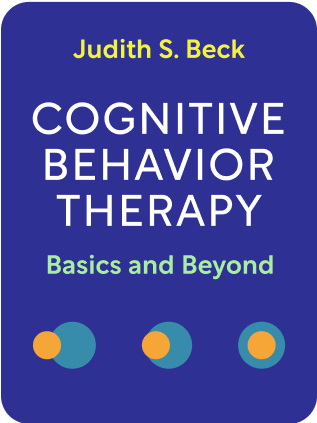

This article is an excerpt from the Shortform book guide to "Cognitive Behavior Therapy: Basics and Beyond" by Judith S. Beck. Shortform has the world's best summaries and analyses of books you should be reading.
Like this article? Sign up for a free trial here .
Do you want to better understand cognitive behavioral therapy? What is CBT used for?
Cognitive behavioral therapy (CBT) is a standard first line of treatment for improving mental health disorders such as depression and anxiety. Understanding CBT, what it’s used for, and how it works can help you to improve your skills as a therapist. Even if you’re not a therapist, CBT techniques are generally applicable to everyday life.
So what is CBT used for? Keep reading to find out.
What Is CBT Used for?
Do you ever find yourself in stressful situations, rationally knowing you shouldn’t be stressed? Have you stopped wishing you’d think self-defeating thoughts, mustering more courage to do the things you’ve wanted to do? You might find elements of cognitive behavioral therapy to be useful.
Cognitive behavioral therapy (CBT) is often used as a treatment for mental health disorders such as depression and anxiety. CBT has been found to be as effective as medication in treating many mental disorders.
But what is CBT used for? Generally, CBT is used to challenge dysfunctional thinking patterns.
The cognitive model proposes that dysfunctional thinking is common to all psychological disturbances. In this way, mental illnesses such as depression and anxiety may be considered thinking disorders. The patient has automatic dysfunctional self-talk that influences behavior negatively; the behavior is then interpreted in a negatively biased way, leading to worse thinking. This reinforces itself into a vicious cycle.
- Example: A patient wants to try something new. She thinks, “you’re definitely going to fail, you’re not good at anything.” → Anxious about failing, the patient declines to try the new activity. → She then thinks, “I told you, you can’t get anything right—you’re worthless.”
The negative thinking extends to the core of a patient’s beliefs about herself, the world, and other people, as well as intermediate levels of attitudes, rules, and assumptions the patient holds.
It’s not just the situation itself that makes a person feel a certain way, but also how they construe it, what lens they use to view it.
- Cyclical downfalls can be triggered by precipitating factors, such as a sudden provocation in stress.
- The patient may have had key developmental events earlier in life that predispose her to the condition.
- The patient may have developed coping mechanisms (adaptive and maladaptive) for the dysfunctional beliefs.
The key point of cognitive behavior therapy is that these dysfunctional beliefs can be unlearned.
Principles of Treatment
If you want to understand what CBT is used for, it’s important to understand the principles of treatment. Cognitive Behavioral Therapy (CBT) is directed toward solving current problems and modifying dysfunctional thinking and behavior. Changing the underlying belief system leads to enduring behavior change.
CBT encourages the patient to:
- Recognize the negative thoughts that are happening automatically.
- Recognize the biased interpretations of their experiences.
- Examine the evidence of a situation. View their experiences from a more realistic and objective perspective.
- Example: Instead of thinking “I can’t do anything right,” patients are led to think, “I’m not good at this specific task. But I’m good at others.”
- Experiment with exposure to situations they fear to test their negative predictions.
- Reflect on their experiments to adjust their beliefs.
The cardinal question of CBT: “What was just going through my mind?”
CBT treatment has 6 characteristics. Knowing these will help you understand what CBT is used for and what kind of issues it tackles.
1) CBT is Collaborative
- The therapist and patient work together on the session agenda and after-session homework. As the patient improves, the patient takes more initiative.
- The therapist shares the conceptualization to ensure it “rings true,” rather than forcing her understanding on the patient.
- The therapist provides rationales for intervention and elicits approval.
- The therapist constantly ends suggestions with “is that OK? Does that sound right?”
- The therapist asks for feedback at the end of each session.
- The pair uses guided discovery, Socratic questioning, and empiricism to explore the validity of automatic thought and test new situations.
2) CBT is Time-bound. Straightforward patients are empowered to be self-sufficient after 6-14 sessions, followed by periodic booster sessions.
- After each session, the patient takes home therapy notes to review.
- The patient carries coping cards with written statements that are important to remember.
- As the therapist demonstrates techniques like problem-solving, she teaches the patient how to apply those techniques alone.
- The patient learns to conduct her own CBT sessions.
3) CBT is Customized to the disorder and to the patient.
- Different disorders require different approaches.
- Panic disorder involves testing catastrophic misinterpretations of bodily/mental sensations.
- Anorexia requires modifying beliefs about personal worth and control.
- Substance abuse focuses on beliefs about the self and permission-granting beliefs about substance abuse.
- Each patient has different thinking patterns, beliefs, and developmental events.
4) CBT is Present-focused. CBT is goal-oriented, current problem-focused.
- Contrast this to Freudian psychoanalysis, which tends to focus on unconscious conflicts and past events.
- Strategies are devised to overcome current problems. This often consists of evaluating the evidence of the situation, creating incremental solutions to experiment with the situation, changing beliefs.
- Attention can shift to the past when patients get stuck in their thinking, or when examining childhood roots modifies their rigid ideas. (“With that experience, it’s no wonder you feel that way. Can you see how almost any child who had the same experiences would grow up feeling the same way you do?”)
5) CBT is Built on Trust, which arises with the therapist’s warmth, empathy, genuine regard, and competence.
- Treat patients the way you would like to be treated.
- Accurately summarize the patient’s thoughts and feelings. The patient will feel understood.
- Your previous successes will make the patient feel optimistic about chances of recovery. “I’ve helped other patients much like you.”
6) CBT is Structured. This makes the session more understandable and empowers the patient to do self-therapy. Each CBT session consists of three parts:
- Introduction: Mood check, reviewing the week, setting an agenda.
- Middle: Reviewing homework, discussing problems on the agenda, strategy setting, setting new homework, summarizing.
- Final: Eliciting feedback.
To build collaboration, trust, and structure, use a standard communication approach during a session:
- Tell the patient what you are about to do, why, and say you will invite feedback.
- Do what you said.
- Ask, “Does this ring true? How does that sound?”
This article will help you to understand what CBT is used for generally. In summary, CBT uses various techniques and principles to change dysfunctional automatic thoughts and behaviors.

———End of Preview———
Like what you just read? Read the rest of the world's best book summary and analysis of Judith S. Beck's "Cognitive Behavior Therapy: Basics and Beyond" at Shortform .
Here's what you'll find in our full Cognitive Behavior Therapy: Basics and Beyond summary :
- How to use CBT to overcome anxiety, sadness, anger, frustration, and stress
- How to address traumatic events earlier in your life, so that they have less hold on your thinking today
- The key ways to build rapport as a cognitive behavior therapist






